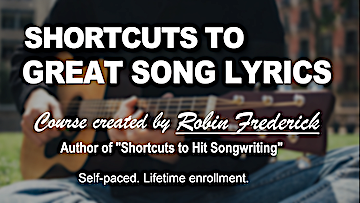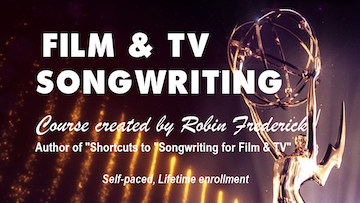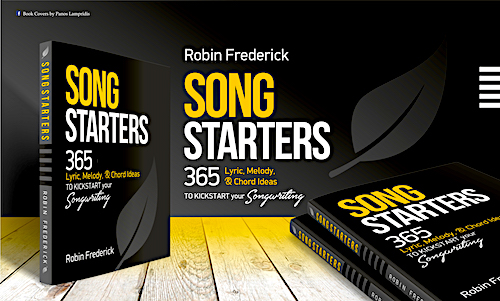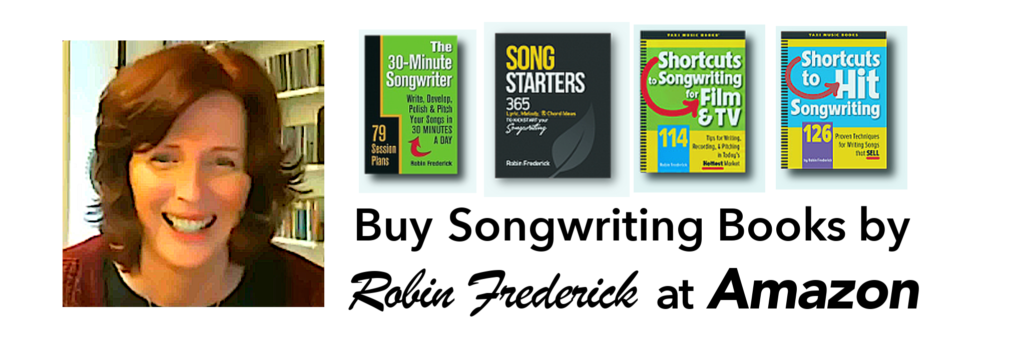You can start a song in dozens of different ways. Start with a title, a melody line, a chord progression, an emotion, or play a rhythm on guitar or keyboard.
Sometimes, though, it helps to have a little push, so I’ve created “song starters” – ideas, titles, themes, development paths, and chord progressions that will get your song going. Feel free to mix and match anything with anything and use it any way you like.
On this page, you’ll find plenty of ideas to get you started. If you’re looking for more, check out my book Song Starters: 365 Lyric, Melody, & Chord Ideas to Kickstart Your Songwriting.
TIP: Start a song with any of the following ideas and spend 30 minutes with it to see where it takes you. Make a rough recording of your idea so you can remember what you did. Then come back to it the next day with fresh ears and develop it further.
START A SONG: SONG TITLES
While there are many ways to start a song, this is one that many pro songwriters use. Starting with a title can keep your song focused, suggest ideas for going forward, and define the overall emotional feel. For more on using a title to start your song, watch this VIDEO.
Here are a few titles for you to play with. Feel free to use them as is, change a word or two, or let them suggest a new idea.
- Walking Home
- Say It to Me Softly
- What’s Stopping You?
- In My Arms Tonight
- Touch the Moon
- Never!
- Racing to Somewhere
- Blue Waters
- Say What?
- Thunder In The Rain
- No Next Time
- Always Good To You
- Closer Than You Think
- Chasing Dreams
- Curves
- Too Late Again
- A Steady Heart
- Change (Can Be a Good Thing)
- A Thousand Times
No doubt some of these titles have already been used in songs but a title can’t be copyrighted, so not to worry. Your challenge is to come up with something that’s uniquely yours in the lyrics, a fresh insight, something original to say about the title.
Look and listen: Titles are all around you. Listen for short phrases that suggest a situation or emotion to you. Look for them in news headlines, magazine stories, and books. Listen for them in the dialogue on TV shows and conversations with friends. Keep a notebook handy and make a list so you always have one when you’re ready to write.
START A SONG: LYRIC THEMES
A theme is a general idea of what you want to write about. Sometimes it’s an emotional situation you’ve experienced. Or it might be a scene from a television series or film. Sometimes an idea will come to you in a burst of inspiration. Here are some of the universal themes that occur over and over in songs, novels, poetry, and paintings.
LOVE RELATIONSHIPS: Falling in love, falling out of love, yearning for love, sick of love, needing love, being in love.
LIFE & SELF: Growing up, becoming independent, rebelling, partying, discovering who you are, overcoming obstacles, meeting challenges.
FAMILY & FRIENDSHIPS: Family ties, celebrations, conflicts.
SOCIETY: Righting wrongs, crossing cultural barriers, alienation, unity, war, social protest, religion.
Read more: Bring Your Lyric Theme to Life.
START A SONG: DEVELOPMENT PATHS
A song is like a journey. The listener starts in one place and ends up in another. They don’t know anything when the song starts. What do you want them to know by the end? Here are a few ideas for development paths you and your listener can travel:
Verse 1: This is the problem.
Chorus: This is how I feel about it.
Verse 2: This is what I tried to do about it.
Chorus: This is how I feel about it.
Bridge: What I hope will happen is this.
Chorus: This is how I feel about it.
Verse 1: Let me tell you about a person I know
Chorus: Here’s how it feels to be around this person
Verse 2: Here’s what they said or did that affected me
Chorus: Here’s how it feels to be around this person
Bridge: This is what I value about this person
Chorus: Here’s how it feels to be around this person
Verse 1: I took a chance
Chorus: Now my life has changed
Verse 2: I risked everything for happiness
Chorus: Now my life has changed
Bridge: It was worth it
Chorus: Now my life has changed
This article will show you how to develop your song in 10 steps.


START A SONG: CHORDS
Here are some popular chord progressions you can use to start your song. Hundreds of hit songs have been written using these chord progressions. You can use them just as they are, or change the order, hold any chord longer, play them fast or slow, or add notes. You can also move them higher or lower by using a capo on guitar or the Transpose function on an electronic keyboard.
Many recent hits repeat these progressions over and over (“Highway Don’t Care” by Tim McGraw, “Stronger” by Kelly Clarkson). In today’s songs, it’s the relation of the melody to the chords that keeps the progression interesting.
Three-chord Progression – A basic progression that still works.
- | D | E A | (Four beats on D, then two beats on E and A).)
Listen to “Live to Be Free” by Griffin House to hear an entire song built on this progression.
Four-Chord Progressions – You can create a whole song from either of these chord progressions. Or use one for the verse, another for the chorus. Or part of one and part of another. Repeat as needed.
- | Am | F | C | G | (One chord per bar)
Listen to “Stronger (What Doesn’t Kill You)” by Kelly Clarkson. The entire song (except for the bridge) is the same four chords in the same order.
- | C | G | Am | F |
Okay, if you haven’t seen “4 Chords” by Axis of Awesome on YouTube – check it out now. 🙂
Full Progression – Try this progression for a complete song.
- Verse: | D | G | C | Em, D | (repeat as needed)
- Pre-chorus: | C | D | C | D |
- Chorus: | G | C | D | Em | (repeat as needed)
JUST FOR FUN: Use a chord progression generator.
START A SONG: MELODIES
Sometimes a lyric will arrive with a melody. Other times a melody might come to you without any words at all. Some people like to start a song with the melody first. If you do that, try to give your melody a structure, with one melody idea for a verse and another for your chorus. Here are a few ideas for starting a melody when you have a few lyric ideas already roughed out…
Use the natural melody of speech: Repeat your lyric lines a few times with LOTS of emotion. The more emotional you are, the more melodic your speaking voice becomes. Notice the rhythm, the natural pauses, the up and down melody of your spoken words. Now, try to turn that into a melody by singing it with your chords. Make adjustments until you have something you like. You don’t have to stick with your first idea. It’s like clay: Keep molding it until you like it.
Use a ghost melody: Just for practice, sing your lyric ideas to the melody of a hit song. Feel free to change the lyric to match the melody. Remember, everything is fluid at this point.
- Change the pitches of the ghost melody. Move low to high or high to low. Change a rising line to a descending one and vice versa.
- Change the rhythm of the ghost melody. If a note is short, hold it out longer, if it’s long, split it into shorter notes.
- Fill in the pauses between lines with words and notes or add a pause where there isn’t one.
- Start the phrases on different beats.
This should give you some melody ideas and a place to start a new song of your own. Remember, the hit song melody is copyrighted. You can’t use any of it in a song you intend to take to market. The fun is in changing it up a lot to see what you end up with.
More ideas on how to rewrite a melody.
RECORD IT
Once you have a rough idea of your verse and chorus, record it into your smartphone, your computer, anything. Just get it down, then walk away! Go do something else. Come back with fresh ears and listen to what you recorded.
If you like it, keep working on it. If not, start from scratch with the same raw material OR move on to another title. But don’t erase what you recorded. You might be surprised how good it sounds tomorrow or next week!

